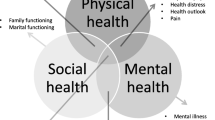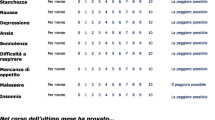Abstract
Purpose
Cancer patients frequently suffer from multiple symptoms often impairing functional status and health-related quality of life (HRQOL). A comprehensive assessment including patient-reported outcomes (PROs) is recommended to enable individualized supportive care. However, PRO assessments are still not part of routine clinical practice. Therefore, this project aimed to compile an item pool from validated assessment instruments to facilitate the use of PROs for clinical decision-making in oncology clinics.
Methods
This qualitative dominant mixed-method cross-sectional exploratory study was carried out in four centers and comprised two stages. Stage I: Six interdisciplinary focus groups were conducted to choose questionnaires meeting particular clinical requirements. Stage II: Adult patients with heterogeneous cancer diagnoses, receiving in- or out-patient treatment were asked to participate and complete the chosen questionnaires (participation 71/74). Resulting PROs were compared with clinical records. Health care professionals (HCPs) and patients rated the usefulness for routine clinical practice.
Results
The European Organisation of Research and Treatment of Cancer (EORTC) QLQ-C30 and Distress Thermometer were chosen for screening and M.D. Anderson Symptom Inventory (MDASI) and EORTC single items for monitoring. Comparison of n = 88 PRO assessments with clinical records showed consistent documentation of side effects like fever and emesis. Symptoms like fatigue, sadness, or sleep disturbance were not documented regularly in the medical records but captured by PRO assessments. Patients and HCPs judged the chosen questionnaires and electronic data collection as useful.
Conclusions
Future studies should examine how PROs can complement or substitute routine documentation in order to achieve standardized assessment and documentation during the treatment process in different settings and examine possible benefits for patients.


Similar content being viewed by others
References
Kroenke K et al (2013) Somatic symptoms in cancer patients trajectory over 12 months and impact on functional status and disability. Support Care Cancer 21(3):765–773
Walker MS et al (2014) Early treatment discontinuation and switching in first-line metastatic breast cancer: the role of patient-reported symptom burden. Breast Cancer Res Treat 144(3):673–681
Trotti A et al (2003) CTCAE v3.0: development of a comprehensive grading system for the adverse effects of cancer treatment. Semin Radiat Oncol 13(3):176–181
Xiao C, Polomano R, Bruner DW (2013) Comparison between patient-reported and clinician-observed symptoms in oncology. Cancer Nurs 36(6):E1–e16
Basch E (2010) The missing voice of patients in drug-safety reporting. N Engl J Med 362(10):865–869
Snyder CF et al (2012) Implementing patient-reported outcomes assessment in clinical practice: a review of the options and considerations. Qual Life Res 21(8):1305–1314
Cleeland CS et al (2000) Assessing symptom distress in cancer patients: the M.D. Anderson Symptom Inventory. Cancer 89(7):1634–1646
Reeve BB et al (2014) Recommended patient-reported core set of symptoms to measure in adult cancer treatment trials. J Natl Cancer Inst 106(7)
Reeve BB et al (2013) ISOQOL recommends minimum standards for patient-reported outcome measures used in patient-centered outcomes and comparative effectiveness research. Qual Life Res 22(8):1889–1905
Howell D et al (2013) Core domains for a person-focused outcome measurement system in cancer (PROMS-Cancer Core) for routine care: a scoping review and Canadian Delphi Consensus. Value Health 16(1):76–87
Kotronoulas G et al (2014) What is the value of the routine use of patient-reported outcome measures toward improvement of patient outcomes, processes of care, and health service outcomes in cancer care? A systematic review of controlled trials. J Clin Oncol 32(14):1480–1501
Snyder CF et al (2014) When using patient-reported outcomes in clinical practice, the measure matters: a randomized controlled trial. J Oncol Pract 10(5):e299–e306
Chen J, Ou L, Hollis SJ (2013) A systematic review of the impact of routine collection of patient reported outcome measures on patients, providers and health organisations in an oncologic setting. BMC Health Serv Res 13:211
Greenhalgh J (2009) The applications of PROs in clinical practice: what are they, do they work, and why? Qual Life Res 18(1):115–123
Snyder CF et al (2011) Can patient-reported outcome measures identify cancer patients’ most bothersome issues? J Clin Oncol 29(9):1216–1220
Huebner J et al (2014) Integrating cancer patients’ perspectives into treatment decisions and treatment evaluation using patient-reported outcomes - a concept paper. Eur J Cancer Care (Engl) 23(2):173–179
Velikova G et al (2010) Patients report improvements in continuity of care when quality of life assessments are used routinely in oncology practice: secondary outcomes of a randomised controlled trial. Eur J Cancer 46(13):2381–2388
Chung AE, Basch EM (2015) Incorporating the patient’s voice into electronic health records through patient-reported outcomes as the “Review of Systems”. J Am Med Inform Assoc
Sigle J, Porzsolt F (1996) Practical aspects of quality-of-life measurement: design and feasibility study of the quality-of-life recorder and the standardized measurement of quality of life in an outpatient clinic. Cancer Treat Rev 22 Suppl A:75–89
Gamper EM et al (2014) The EORTC emotional functioning computerized adaptive test: phases I-III of a cross-cultural item bank development. Psychooncology 23(4):397–403
NCCN (2013) Distress management. Available from: http://www.oralcancerfoundation.org/treatment/pdf/distress.pdf
EHA (2012) Guidelines. Patient reported outcomes in hematology. Genua: forum service editore
NCCN (2014) Cancer-related fatigue. Available from: https://s3.amazonaws.com/pfizerpro.com/fixtures/oncology/docs/NCCNFatigueGuidelines.pdf
Santana MJ et al (2015) Training clinicians in how to use patient-reported outcome measures in routine clinical practice. Qual Life Res
Antunes B, Harding R, Higginson IJ (2014) Implementing patient-reported outcome measures in palliative care clinical practice: a systematic review of facilitators and barriers. Palliat Med 28(2):158–175
Boyce MB, Browne JP, Greenhalgh J (2014) The experiences of professionals with using information from patient-reported outcome measures to improve the quality of healthcare: a systematic review of qualitative research. BMJ Qual Saf 23(6):508–518
Howell D et al (2015) Patient-reported outcomes in routine cancer clinical practice: a scoping review of use, impact on health outcomes, and implementation factors. Ann Oncol
Osoba D (2007) Translating the science of patient-reported outcomes assessment into clinical practice. J Natl Cancer Inst Monogr 37:5–11
Warrington L, Absolom K, Velikova G (2015) Integrated care pathways for cancer survivors - a role for patient-reported outcome measures and health informatics. Acta Oncol 54(5):600–608
Basch E, Abernethy AP (2011) Supporting clinical practice decisions with real-time patient-reported outcomes. J Clin Oncol 29(8):954–956
Cleeland CS, Sloan JA (2010) Assessing the Symptoms of Cancer Using Patient-Reported Outcomes (ASCPRO): searching for standards. J Pain Symptom Manage 39(6):1077–1085
Howell D et al (2012) Psychosocial health care needs assessment of adult cancer patients: a consensus-based guideline. Support Care Cancer
von Elm E et al (2014) The Strengthening the Reporting of Observational Studies in Epidemiology (STROBE) Statement: guidelines for reporting observational studies. Int J Surg 12(12):1495–1499
Johnson RB, Onwuegbuzie AJ, Turner LA (2007) Toward a definition of mixed methods research. J Mixed Methods Res 1(2):112–133
Mayring P (2000) Qualitative content analysis [28 paragraphs]. Forum Qualitative Sozialforschung / Forum: Qualitative Social Research 1(2) Art. 20
Bonomi AE et al (1996) Multilingual translation of the Functional Assessment of Cancer Therapy (FACT) quality of life measurement system. Qual Life Res 5(3):309–320
Aaronson NK et al (1993) The European Organization for Research and Treatment of Cancer QLQ-C30: a quality-of-life instrument for use in international clinical trials in oncology. J Natl Cancer Inst 85(5):365–376
Schaeffeler N et al (2015) Assessing the need for psychooncological support: screening instruments in combination with patients’ subjective evaluation may define psychooncological pathways. Psychooncology
Donovan KA et al (2014) Validation of the distress thermometer worldwide: state of the science. Psychooncology 23(3):241–250
Schmidt H et al (2015) Symptom burden of cancer patients: validation of the German M. D. Anderson Symptom Inventory: a cross-sectional multicenter study. J Pain Symptom Manage 49(1):117–125
Landenberger M et al (2015) Trans-sectoral care for patients with colorectal cancer: design of a prospective randomized controlled multi-center trial (FKZ 01GY1143). Z Evid Fortbild Qual Gesundhwes 109(2):171–180
Brundage MD et al (2015) Communicating patient-reported outcome scores using graphic formats: results from a mixed-methods evaluation. Qual Life Res
Jagsi R et al (2013) Qualitative analysis of practicing oncologists’ attitudes and experiences regarding collection of patient-reported outcomes. J Oncol Pract 9(6):e290–e297
Author information
Authors and Affiliations
Corresponding author
Ethics declarations
Conflict of interest
The work was funded by a grant of the Wilhelm-Roux program of the medical faculty of the Martin Luther University Halle-Wittenberg. The authors state no conflicts of interest related to the work of this study. The authors have full control of all primary data that can be reviewed if requested.
Rights and permissions
About this article
Cite this article
Schmidt, H., Merkel, D., Koehler, M. et al. PRO-ONKO—selection of patient-reported outcome assessments for the clinical use in cancer patients—a mixed-method multicenter cross-sectional exploratory study. Support Care Cancer 24, 2503–2512 (2016). https://doi.org/10.1007/s00520-015-3055-4
Received:
Accepted:
Published:
Issue Date:
DOI: https://doi.org/10.1007/s00520-015-3055-4




